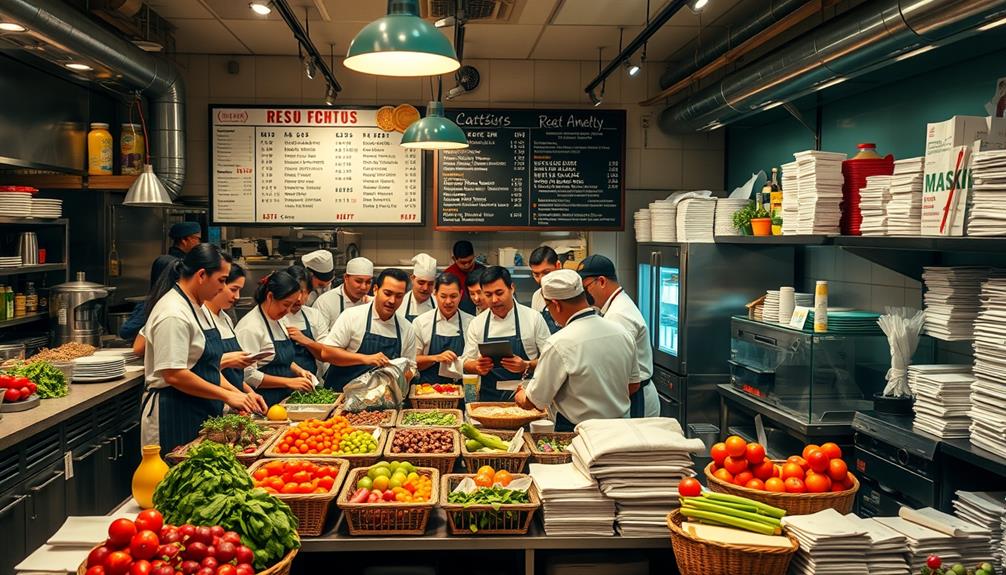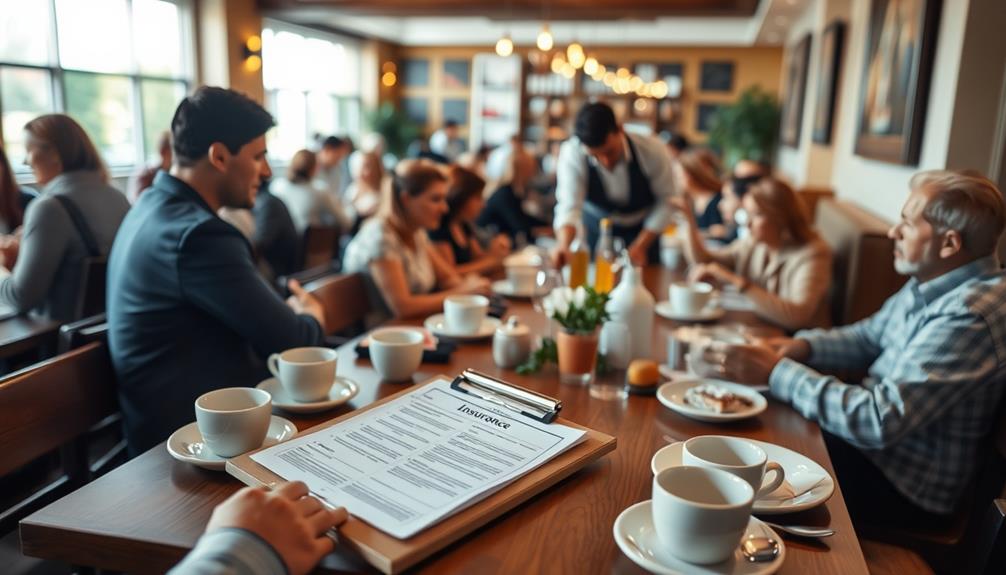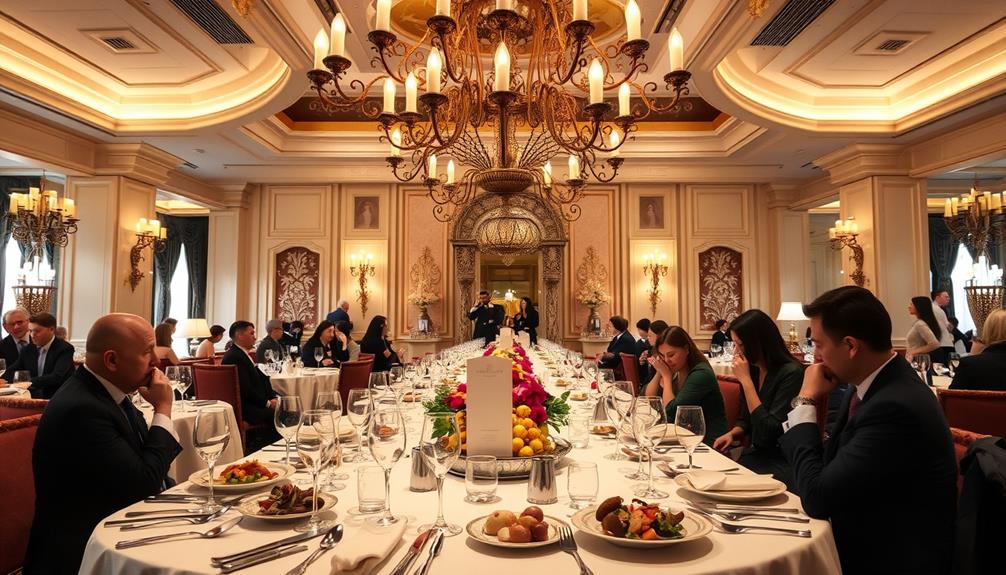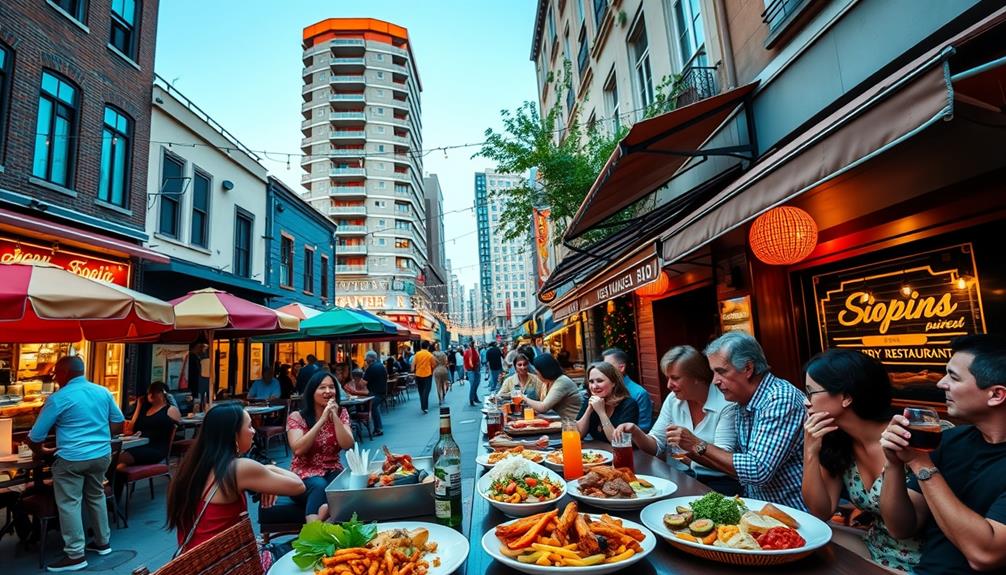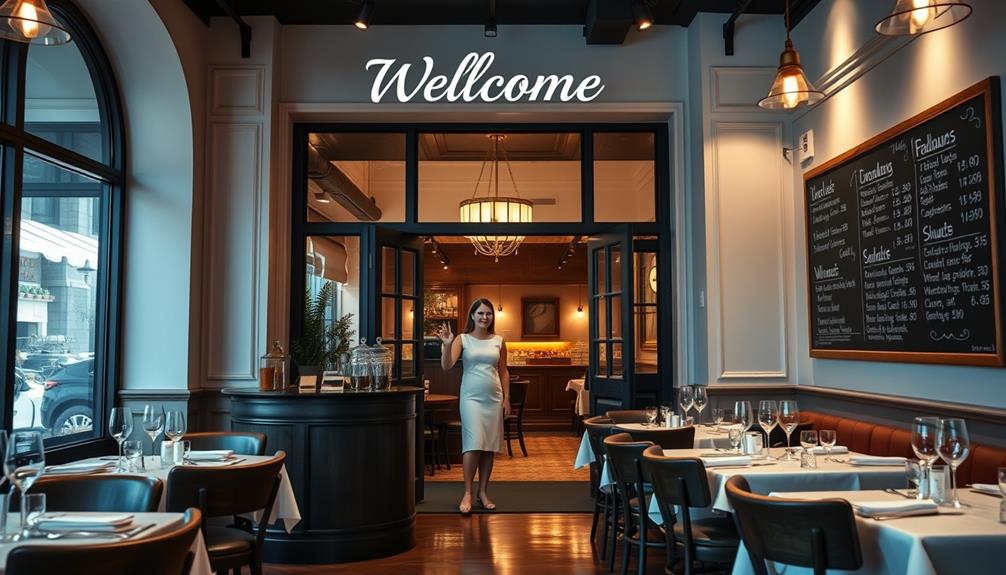Starting a restaurant can set you back anywhere from $250,000 to $500,000, influenced by your location and establishment size. Key costs arise from rent, which averages around $5,000 a month, and utilities, typically between $1,000 and $1,200 monthly. Labor accounts for about 25-30% of your total expenses, while food costs range from 28% to 35%. Don't forget about permits and licenses, which can run anywhere from $2,500 to $200,000. With careful planning, you can navigate these expenses successfully, and there's more to reflect on as you prepare for your venture ahead.
Key Takeaways
- Initial startup costs typically range from $500 to $2,000, with equipment and remodeling expenses significantly impacting the budget.
- Monthly rent averages around $5,000, accounting for 5%-10% of total operating expenses.
- Labor costs represent 25%-30% of overall expenses, influenced by salaries and employee benefits.
- Food and inventory costs fluctuate between 28%-35% of ongoing expenses, with food waste affecting profitability.
- Licensing and permits can cost between $2,500 to $200,000, depending on type and location.
Costs of Space and Utilities
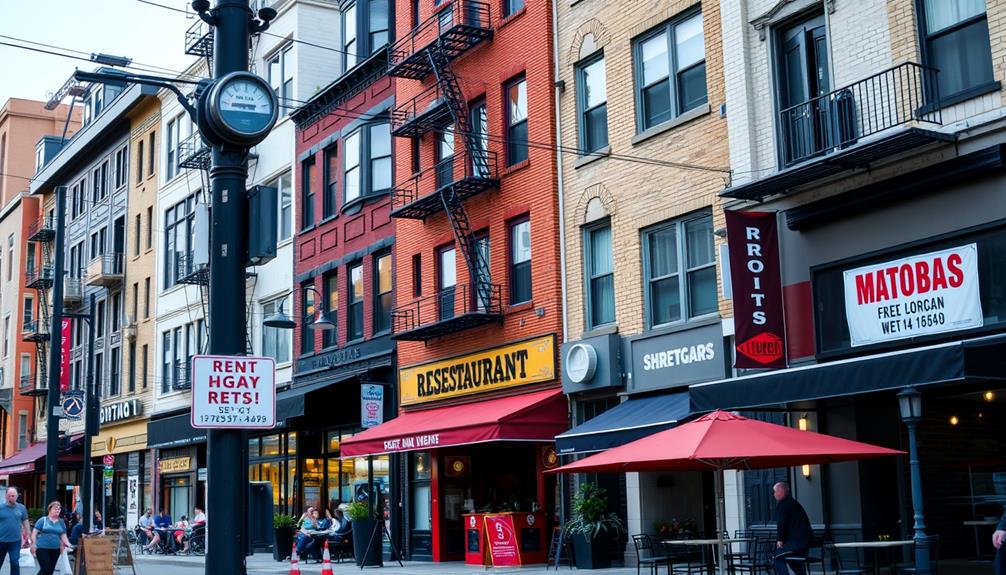
When you're starting a restaurant, understanding the costs of space and utilities is vital to your budget. The average monthly rent for a restaurant typically hovers around $5,000, making up about 5% to 10% of your total operating costs. However, these rental costs can vary widely based on your location and the type of restaurant you choose.
If you opt for a ghost kitchen, you could greatly reduce your rental expenses, needing only 200-300 square feet compared to the 2,000 square feet required for traditional restaurants. Additionally, it's important to take into account the impact of financial terms and jargon, as understanding them can help you make informed decisions regarding your restaurant's finances.
Utility expenses will also impact your budget, usually accounting for 3% to 5% of overall operating costs. For a commercial space around 4,000-4,500 square feet, you might expect utility costs to range from $1,000 to $1,200 monthly.
Keep in mind that during the construction phase, you'll need to manage utility usage carefully to avoid escalating costs. Electricity and natural gas costs can add up quickly, averaging $2.90 and $0.85 per square foot annually, respectively.
Planning for these expenses is essential to guarantee your restaurant startup costs remain manageable.
Labor and Employee Expenses
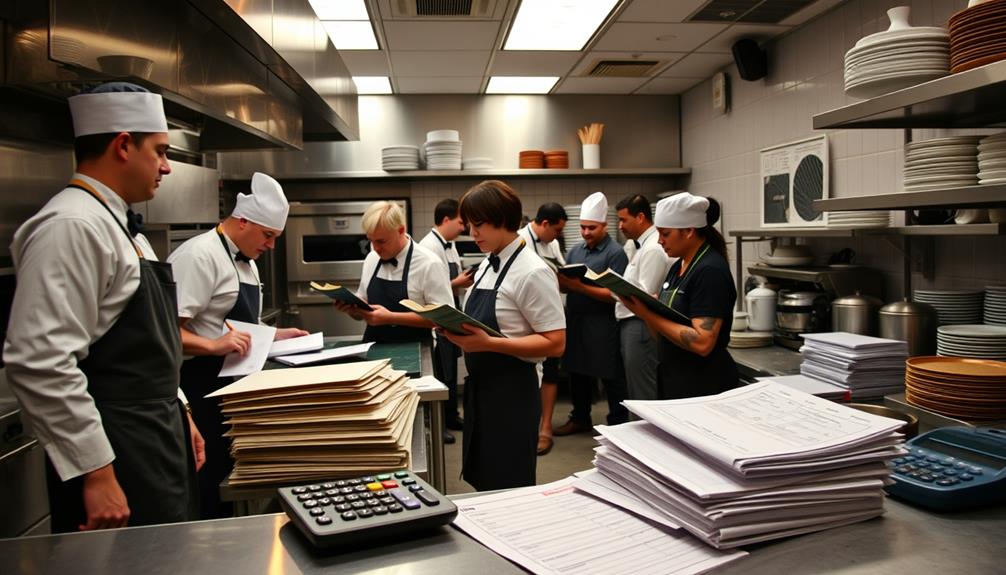
Labor and employee expenses are essential components of your restaurant's budget right from the start. Labor costs typically range from 25% to 30% of your total operating expenses. Understanding employee salaries is important, as salaried managers earn between $28,000 to $55,000 annually, while chef salaries can vary from $1,300 to $1,800 per week.
Calculating your labor cost percentage is key; divide total labor costs by total sales and multiply by 100. With about 70% of restaurants facing labor shortages, these staffing challenges can lead to increased labor costs and affect your bottom line.
Here's a quick overview of potential labor-related expenses:
| Expense Type | Estimated Range | Notes |
|---|---|---|
| Manager Salaries | $28,000 – $55,000 | Annual income |
| Chef Salaries | $1,300 – $1,800/week | Weekly income |
| Payroll Taxes | Varies | Depends on total employee salaries |
Don't forget to factor in employee benefits, as they can greatly contribute to your overall labor expenses. Effective management is important for controlling these costs.
Food and Inventory Costs

Managing food and inventory costs is essential for your restaurant's success. Food costs typically account for 28% to 35% of your ongoing expenses, and for steakhouses, this can soar to 40%. To maintain profitability, you'll need effective inventory management.
Many restaurants struggle with food waste, with 58% reporting challenges in this area. This waste directly impacts your bottom line, so precise tracking of your food costs and inventory is vital. Additionally, implementing a methodical approach to inventory management can greatly improve your operational efficiency.
Best practices in quality assurance can also be applied to streamline food cost tracking.
Building strong vendor relationships is another key factor. About 40% of restaurant owners actively negotiate to keep food costs low, which can greatly affect your operating expenses.
While food cost percentages matter, remember that the profitability of your menu items also relies on factors like pricing strategy and customer demand.
Consistently tracking your expenses will help you identify areas where you can cut costs without compromising quality. By focusing on these elements, you can enhance your restaurant's overall financial health, ensuring you stay competitive and profitable in a challenging market.
Technology Investments
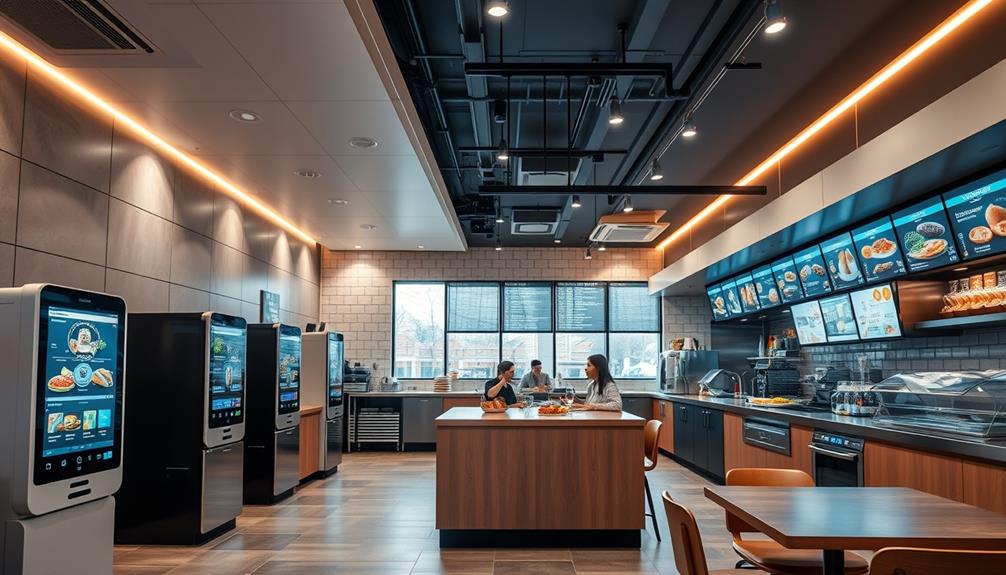
Investing in technology is essential for running a successful restaurant today. It not only enhances operational efficiency but also improves customer experience.
As a restaurant startup, you'll need to evaluate several key technology investments, especially as researching potential investments can help minimize risks. Additionally, implementing effective systems can lead to better decision-making and ultimately drive profitability.
- POS System: Starting at around $89 per month, a good POS system streamlines operations and elevates customer service.
- Kitchen Display Systems (KDS): Minimum hardware costs for KDS can start at about $1,000, contributing to your initial setup expenses.
- Employee Scheduling Software: This can save you significant time, especially since 25% of restaurants report spending over three hours weekly on manual scheduling, leading to potential labor cost savings.
- Loyalty Programs and Contactless Payment: These features are becoming standard, with 34% of customers prioritizing them when choosing where to dine.
Licensing and Permits
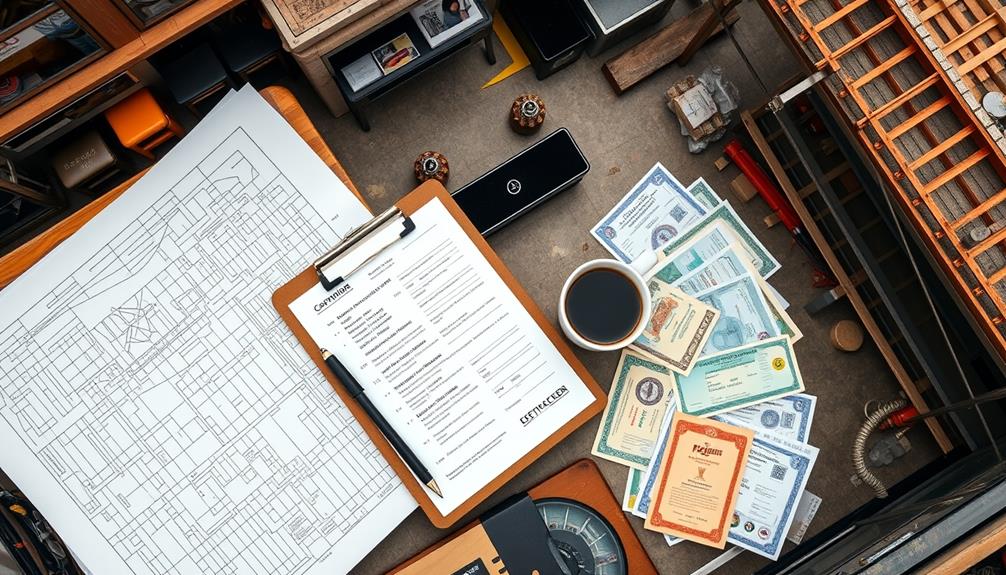
After you've lined up your technology investments, it's time to tackle the necessary licenses and permits required to operate your restaurant legally. Securing restaurant licenses and permits is an essential step that can greatly impact your overall startup expenses.
Depending on your establishment's type and location, these startup costs can range from $2,500 to $200,000. It's also important to take into account the potential side effects and interactions of any products you might be offering, as they can affect customer safety and satisfaction. For example, cold medications overview is critical if you plan to serve items that may interact with such medications.
Most restaurants need at least six fundamental permits, including a business license, food service license, and Certificate of Occupancy. A food service license typically costs between $100 and $1,000, while liquor licenses can be considerably more expensive, varying from $300 to $14,000 based on state regulations.
Don't forget about legal and processing fees, which can add another $500 to $2,000 to your budget.
It's essential to secure all necessary permits early in the planning process. Delays in obtaining these licenses can lead to potential fines and setbacks during your restaurant's launch. By proactively addressing these requirements, you'll guarantee a smoother opening and a more successful start to your culinary venture.
Startup Cost Breakdown
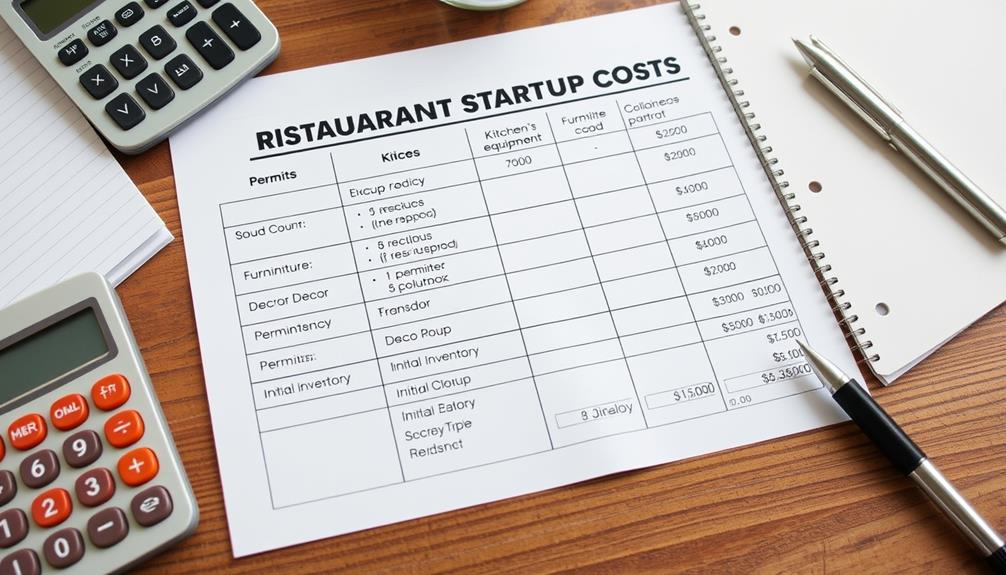
When you're starting a restaurant, understanding your startup costs is vital.
You'll face one-time expenses for equipment, furniture, and licenses, alongside recurring operational costs like utilities.
A thorough holistic SEO approach can help guarantee your restaurant's online presence is robust, which is essential for attracting customers.
Let's break down these financial components to give you a clearer picture of what to expect.
One-Time Expenses Overview
Starting a restaurant involves a variety of one-time expenses that can add up quickly. You'll want to carefully consider these startup costs to avoid any surprises down the line. Understanding the significance of financial planning, including potential funding options, can be beneficial for new restaurant owners.
Here's a breakdown of the key one-time expenses you should prepare for:
- Security Deposits and Loan Payments: Expect to pay between $2,000 to $12,000 depending on your location.
- Business Licenses and Permits: These can range from $100 to $300 each, so factor in the number needed for operation.
- Legal Fees: Securing necessary documentation can cost between $500 and $2,000, depending on complexity.
- Building Improvements and Kitchen Equipment: Remodeling expenses can reach $250,000 to $350,000, while kitchen equipment costs vary from $50,000 to $150,000, depending on your setup.
Keep in mind that these one-time expenses, including permit costs and any restaurant renovation, play a vital role in your overall budget.
Planning ahead can help you manage these costs effectively and set your restaurant up for success.
Recurring Operational Costs
Many new restaurant owners underestimate the importance of recurring operational costs, which can greatly impact your bottom line. Understanding these ongoing expenses is essential for your restaurant's success, especially considering that there are various ways to earn money online, such as freelance gigs that could supplement your income.
Rent typically sets you back around $5,000 per month, making up 5% to 10% of your total operating expenses. Utilities can add another $1,000 to $1,200 monthly, representing 3% to 5% of your costs.
Labor costs are another significant factor, often accounting for 25% to 30% of your operating expenses. Many in the restaurant industry struggle with hiring and retaining staff, so it's imperative to budget accordingly.
Then, there are your food costs, which usually hit 28% to 35% of ongoing expenses; these fluctuate based on your menu and vendor relationships.
Don't forget about marketing expenses, either. To maintain visibility and attract a loyal customer base, it's wise to allocate 3-6% of your sales for marketing.
Frequently Asked Questions
How Much Money Should You Have to Open a Small Restaurant?
To open a small restaurant, you should aim for at least $20,000 to $250,000. This range covers initial expenses, including equipment, permits, and first-month operations, ensuring you're financially prepared for a successful launch. Furthermore, it’s important to research restaurant construction costs in your area to ensure you have enough funding for building or renovating the space. Additionally, budget for marketing and advertising expenses to attract customers to your new establishment. By thoroughly planning and budgeting for these various expenses, you can set your small restaurant up for long-term success.
How Profitable Is Owning a Restaurant?
Owning a restaurant can feel like walking a tightrope. You'll find profit margins typically range from 3% to 5%. By mastering cost control and menu pricing, you can tip the scales in your favor.
What Is the Startup Cost for a Small Restaurant?
When considering startup costs for a small restaurant, you'll need to factor in expenses like rent, utilities, food, labor, and licenses. Planning for pre-operating costs is vital to guarantee your restaurant's success.
Can You Start a Small Restaurant With ,000 Dollars?
You can't even start a lemonade stand with just $10,000! Opening a small restaurant demands considerably more for essentials like permits, equipment, and initial inventory, so you'll need a much larger budget to succeed.
Conclusion
Starting a restaurant can be a thrilling yet taxing venture, but with careful calculation, you can conquer costs effectively. Remember, every dollar counts, so budget wisely and balance your basics. By budgeting for space, staffing, supplies, and systems, you'll set yourself up for success. Don't let intimidating details drag you down; instead, plunge into the delicious world of dining with determination. With the right preparation, your culinary dreams can become a reality!
